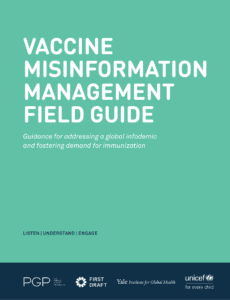Misinformation Alerts
Knowing what misinformation is being shared can help you generate effective messaging.
These insights are based on a combination of automated media monitoring and manual review by public health data analysts. Media data are publicly available data from many sources, such as social media, broadcast television, newspapers and magazines, news websites, online video, blogs, and more. Analysts from the Public Good Projects triangulate this data along with other data from fact checking organizations and investigative sources to provide an accurate, but not exhaustive, list of currently circulating misinformation.
Misinformation Alerts
Knowing what misinformation is being shared can help you generate effective messaging.
These insights are based on a combination of automated media monitoring and manual review by public health data analysts. Media data are publicly available data from many sources, such as social media, broadcast television, newspapers and magazines, news websites, online video, blogs, and more. Analysts from the Public Good Projects triangulate this data along with other data from fact checking organizations and investigative sources to provide an accurate, but not exhaustive, list of currently circulating misinformation.Alerts are categorized as high, medium, and low risk.
- High risk alerts: Narratives with widespread circulation across communities, high engagement, exponential velocity, and a high potential to impact health decisions. Are often more memorable than accurate information.
- Medium risk alerts: Narratives that are circulating in priority populations and pose some threat to health. Potential for further spread due to the tactics used or because of predicted velocity. Often highlights the questions and concerns of people.
- Low risk alerts: Narratives that are limited in reach, don’t impact your community, or lack the qualities necessary for future spread. May indicate information gaps, confusion, or concerns.
A far-right news site published an article that repeated the false claim that COVID-19 vaccine boosters weaken the immune system. The article has been shared thousands of times on social media.
Recommendation: The persistence of the claim and its potential to cause hesitancy increases its risk. The myth that COVID-19 vaccines and boosters weaken the immune system has circulated for years, with no evidence to support it. Debunking messaging may emphasize that vaccines do not negatively affect immune cells or the immune system as a whole. Instead, they strengthen the immune system’s ability to fight COVID-19. Fact Checking Source(s): FactCheck.org, Reuters
The producers of a viral conspiracy film that falsely claimed COVID-19 vaccines cause people to die suddenly released a trailer for a second, equally unsubstantiated “documentary.” The new film repeats several conspiracy theories, including that COVID-19 vaccines are bioweapons, that governments planned the pandemic to control people, and that SARS-CoV-2 was developed by pharmaceutical research.
Recommendation: The first film had a lasting impact on anti-vaccine narratives, which increases the potential risk of the new film. Debunking messaging may emphasize that the trailer for the new film, like the original, is full of misleading quotes, misrepresentations, and blatant lies. The claim that the vaccines are bioweapons is based on an interview with a Pfizer “whistleblower” who didn’t work in vaccine research. There is no evidence to support the conspiracy theory that governments or pharmaceutical companies were involved in the COVID-19 pandemic. COVID-19 is caused by a coronavirus, a family of viruses that caused multiple major outbreaks in the two decades leading up to the pandemic. Continuing to emphasize that over 70 percent of the world’s population has been safely vaccinated against COVID-19 with no evidence of widespread health issues is recommended. Fact-Checking Source(s): 
Social media posts in multiple languages are recirculating the conspiracy theory that a WHO pandemic treaty allows the organization to impose lockdowns, vaccine requirements, and quarantines on countries. Several large-follower accounts have repeated the claim.
Recommendation: The persistence of the false claim increases its risk. This misinformation has been circulating since WHO announced negotiations for a global “pandemic prevention, preparedness, and response” agreement. Debunking messaging may explain that the treaty is voluntary and doesn’t grant WHO authority over national policies. Instead, the document, which hasn't been ratified, is a list of recommendations for international pandemic preparedness. Fact Checking Source(s): Logically, AFP, FactCheck.org
An FDA study of over 3 million children confirmed that COVID-19 vaccines are safe for children and adolescents aged 5 to 17. The study found a slight increase in myocarditis risk in older children the week after vaccination, primarily in boys aged 12 to 17. Anti-vaccine sites falsely claim that the study proves vaccines are unsafe for children.
Recommendation: The widespread nature of the misinformation elevates its risk. Debunking messaging may emphasize that, of the 153 myocarditis and pericarditis cases reported in older children, most resolved quickly, and none were fatal. No safety concerns were identified for children under 12. Like previous studies, this study confirms that serious risks from COVID-19 vaccination are extremely rare. Emphasizing that the risk of heart issues is significantly higher in every age group after COVID-19 infection than after vaccination is recommended. Fact Checking Source(s): CIDRAP, Forbes
Posts trending in multiple languages claim that a WHO study found that COVID-19 vaccines cause multiple sclerosis (MS), a disease in which the immune system attacks nerve cells. The posts include screenshots of the study falsely attributed to the WHO website.
Recommendation: The misinformation was promoted by several popular accounts with large audiences, increasing its risk. Debunking messaging may emphasize the study was never peer-reviewed and wasn't conducted, funded, or endorsed by the organization. The research is a case report presented at a conference, which describes two vaccinated people, out of billions, who were diagnosed with MS. It does not provide any evidence that COVID-19 vaccination causes MS. Fact Checking Source(s): AP News
An article circulating on social media claims that childhood vaccines are the primary driver of the so-called "autism epidemic." The article falsely claims 100 “top scientists” agree that vaccines cause autism. The source of the claim appears to be an anecdote from a blog post authored by a tech entrepreneur and anti-vaccine conspiracist.
Recommendation: The myth that vaccines cause autism is widespread and persistent, hence the high risk. Debunking messaging may emphasize that scientists have investigated a potential link between vaccines and autism for decades and have never found evidence to support any connection. The study that originally claimed that vaccines cause autism was retracted after it was found to involve unethical research practices. No subsequent studies have found a causal link between any vaccine and autism. Fact-Checking Source(s): 
An anti-vaccine conspiracy theorist with a large following falsely claims that most SIDS cases occur within 10 days of vaccination. The post also repeats the debunked myth that SIDS “disappeared” in Japan after the country delayed the vaccination schedule by two years.
Recommendation: The persistence of the myth increases its risk. Debunking messaging may explain that multiple studies have ruled out vaccines as a cause of SIDS, including a global analysis that found that vaccinated babies have a lower SIDS risk than unvaccinated babies. Other studies have shown no increase in SIDS rates in the two weeks after vaccination. Consider countering misinformation by explaining that Japan’s recommended immunization schedule is similar to the CDC’s and includes around 10 vaccinations before age 2. Fact Checking Source(s): CHOP, Full Fact 
A popular anti-vaccine organization published an article claiming that the respiratory syncytial virus (RSV) vaccine is dangerous for pregnant women and their babies. The article also misrepresented clinical trial safety data.
Recommendation: The article’s inflammatory nature and its potential to cause vaccine hesitancy raises the risk. Debunking messaging may explain that the FDA rigorously reviewed clinical trial safety data before recommending the vaccine during the second or third trimester to protect newborns, who are particularly vulnerable to RSV. Messaging may also emphasize that the claim misrepresents clinical trial data that found a slight but not statistically significant increase in preterm birth, which means that the increase could be due to chance rather than related to the vaccine. It’s also important to note that the vaccinated group's preterm birth rate was lower than the national average. Fact-Checking Source(s): 
An image resurfaced the debunked claim that the U.S. military has seen a 500 percent increase in HIV rates since the COVID-19 vaccine rollout and is now HIV-testing vaccinated soldiers.
Recommendation: Responding to every piece of misinformation may detract from priority talking points. If a response is needed, consider countering by explaining that the Department of Defense (DoD) states that the claim is a false story that has circulated for over a year. Increased HIV infections in 2021 were due to underreporting in the previous five years. The number of cases increased after uncounted cases from these years were added to DoD medical databases. Fact-checking sources:
A video circulating on social media promotes the conspiracy theory that COVID-19 vaccines cause people to emit and receive Bluetooth signals. The video, which has since been removed from the platform, claims that the theory was tested on buried bodies of people who allegedly died from COVID-19 vaccine injuries. A variation of this myth also circulated two years ago.
Recommendation: Responding to conspiracy theories may detract from priority talking points. Messaging may explain that COVID-19 vaccines don’t contain microchips, including those that enable devices to connect to Bluetooth. Fact-checking sources:
Alerts are categorized as high, medium, and low risk.
- High risk alerts: Narratives with widespread circulation across communities, high engagement, exponential velocity, and a high potential to impact health decisions. Are often more memorable than accurate information.
- Medium risk alerts: Narratives that are circulating in priority populations and pose some threat to health. Potential for further spread due to the tactics used or because of predicted velocity. Often highlights the questions and concerns of people.
- Low risk alerts: Narratives that are limited in reach, don’t impact your community, or lack the qualities necessary for future spread. May indicate information gaps, confusion, or concerns.
Vaccine Misinformation Guide
Get practical tips for addressing misinformation in this new guide. Click image to download, or see highlights.



